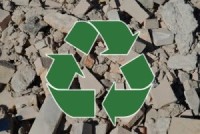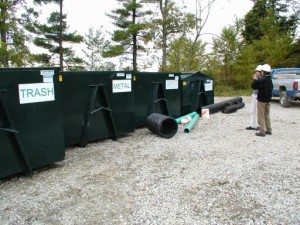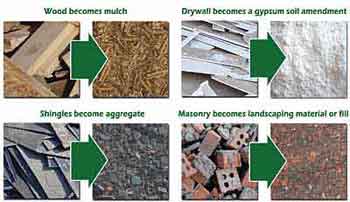Formation Building Construction Waste Management Scenario

 Under the LEED certification category of Materials & Resources is Construction Waste Management, a project credit typically worth up to 2 points. Projects pursuing LEED certification can earn one point for 50% and two for 75% construction waste—either by weight or by volume—diverted from landfills.
Under the LEED certification category of Materials & Resources is Construction Waste Management, a project credit typically worth up to 2 points. Projects pursuing LEED certification can earn one point for 50% and two for 75% construction waste—either by weight or by volume—diverted from landfills.
The Formation Building general contractor proposed as of now is The Whiting-Turner Contracting Co. of Baltimore. When interviewing two of its reps at the beginning of the year (one of 4 general contracting firms interviewed), Vice President Irene Knott told the A&E Committee that her firm has averaged over 80% recycled or salvaged construction waste on LEED projects. When challenged for Exemplary Performance for the credit, worth an additional point, she said 95% was very difficult to achieve, but we could count on 75%. Sold!
Both for new construction and major renovation, the general contractor may well sort materials on-site according to the LEED-required construction waste management plan it devises. I’ve seen it done this way on plenty of other LEED projects; and, for that matter, non-LEED projects too as the combined economics of construction materials costs and landfill avoidance have increasingly favored recycling and salvage in the recent years. Alternative is to co-mingle at the site for separation off-site. The amount of space available for the containers (not dumpsters) on-site usually dictates which means is chosen.
According to a Wisconsin Department of Natural Resources report of a few years ago, “the construction industry likely generates 20-26 percent of [all] solid waste in the U.S.” per year. Per a U.S. Green Building Council white paper: “More than 135 Million tons of debris from construction sites is brought to U.S. landfills every year, making it the single largest source in the waste stream.”
Another metric offered offered by the Wisconsin DNR: Commercial construction generates between 2 and 2-1/2 pounds of solid waste per square foot. (A different source pegs it at 3.9 pounds.) For the Formation Building, a reasonable estimate based on this statistic would be more than 19 tons—so, 14-15 or more tons diverted from the County landfill! This is an avoided cost of landfill depletion.
estimate based on this statistic would be more than 19 tons—so, 14-15 or more tons diverted from the County landfill! This is an avoided cost of landfill depletion.
Come to think of it, the first diverted-from-landfill salvaged material of the new building are the white pine and red cedar trees which previously set on the building footprint, and since then have been milled into planks. That wood is now properly stacked and air drying for repurposing in the Formation Building. No LEED points, per se, for this, but a gesture of outstanding environmental stewardship at St. Margaret’s!
Say, for 4 minutes of viewing pleasure for some of you, see this YouTube video on the recycling of construction waste at a brick and block manufacturer in South Africa.